A stack of old miniatures
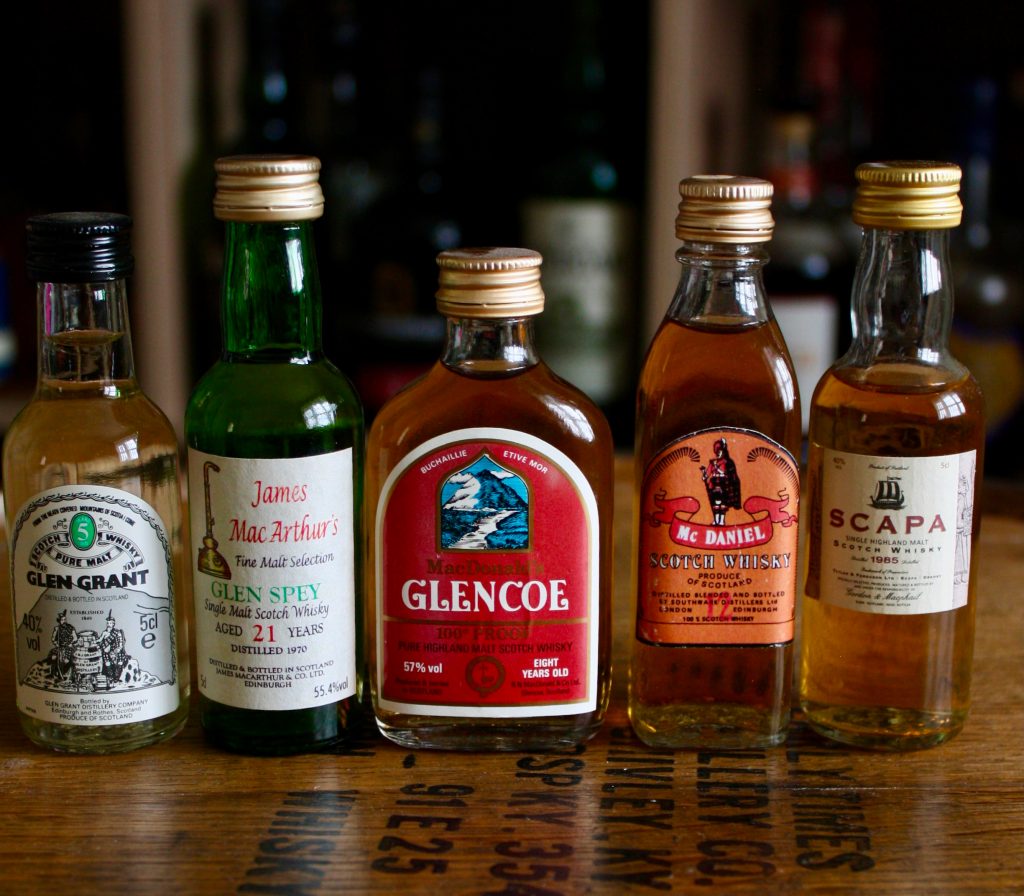
I’ve often thought and vocalised my opinion that whisky miniatures are underappreciated, particularly the old miniatures that crop up at auction. They give you the opportunity to sample whisky from decades previous, but with only a small investment, so you can relax if it isn’t as good as you hoped, knowing it hasn’t broken the bank.
Of course, whether you have broken the bank or not depends on which price point you are operating at. As with any auction there is a higher, more premium end of the market. Not many will be looking at 1919 Springbank or 1959 Malt Mill, which have appeared at the recent Whisky.auction miniature and memorabilia auction. Three bottles of 1919 Springbank have appeared at these auctions in recent years, all with very poor fill levels. The one with the best fill level sold for £2100 back in 2016, but such has the market moved on since, one sold for £5600 in August 2021, and the latest one ended on a figure of £6400. Much of this will be to do with the global collectors and investors market gathering pace, and the Springbank name growing with it. Its worth saying all prices in this article I am quoting don’t include fees, which are minimal when you are spending a few pounds, but soon add up when you are spending thousands.
The Malt Mill, with a far from air tight provenance, went on to sell for £5800. Only 4 of these miniatures were ever bottled, and was reported to come from a former distillery worker, who handed over the cask sample in exchange for £20 at a pub in Bowmore in the 1990’s. It was then bottled by James MacArthur & Co. The previous one sold for £3800 in 2018, and was subsequently opened and consumed. Serge Valentin was one of the lucky people to taste the liquid, along with Angus MacRaild and purchaser Emmanuel Dron, who all scored it rather favourably. Interestingly, the purchasers of the sample, Alex Barclay and Mike Barbakoff, didn’t think much of it when they tried it. We’ll perhaps never know if it is genuine, unless some sort of analysis can be carried out with the small bottle of new make Lagavulin have at their distillery. Even if it were possible, would you risk ruining the myth and the value of your bottle if you had paid £5800?
I’d imagine the Springbank and Malt Mill will become shelf pieces, due to be sold on again in years to come for even more money by investors. I am operating at a much much lower area of the market. I think the most I have paid so far is around £20 for malts from Glencraig and Dallas Dhu. More often I am spending between £2 and £10 for them. Some of the whiskies I am buying clearly have no interest to most other people, but that doesn’t bother me. The right time to buy is when the prices are low, and i’m not in it for financial investment anyway. As with the larger bottle equivalents, the collectors in the miniature market are mostly focussed on the big names, such as the aforementioned Springbank, Ardbeg, Macallan, Dalmore, Port Ellen, Talisker and Yamazaki.
The auction “attendance” figures further prove there is less interest in the miniature. Whisky.auction regularly hold specialist miniature auctions, as well as ones for regular whisky bottles. There were 299 bidders across the latest miniature auction, where as the most recent regular whisky auction pulled in 770 bidders. It’s a similar story looking further back too. The love just isn’t there for the mini.
My personal love of the mini goes right back to childhood. I wouldn’t describe my gran as a collector, but the first thing that greeted visitors into her hallway of her 1930s semi, was narrow shelving going around the entire hallway, with whisky, and other spirit miniatures lined up on top. Most were empty, but she clearly saw their aesthetic value, and I did too. Add that to the fact she was from a generation that threw nothing away.
When I pick up an old blend or malt at auction, i’m thinking about the history of that liquid. I may not know what whiskies have made up the blends, but whatever they are, they are going back to an age where whisky production was different. Whisky producers have become more consistent in the way they produce their product in recent times, which has major plus points in terms of keeping the quality standard constant, but for all the bad whiskies produced decades ago, there are also some gems that would never have happened in the modern day. In the case of a malt, I can look back at what the distillery was like back when it was distilled, and in what ways it may have changed since. If its a blend I can do some research and try and discover more about it. I can perhaps find a modern day whisky from the distillery/blender and compare the two. You may well get some old bottle effect, and occasionally you will get a whisky that hasn’t survived its years in bottle and tastes like cabbage water, but i’m finding those few and far between so far. Some of the old labels are fantastic too, if you are into that kind of thing.
For this review I am going to sample a few of my recent auction purchases. Some may be good, some may be bad, but I will be better off for the experience either way.
The Macdonald’s Glencoe 8 Pure Highland Malt is one that will pop-up at pretty much every auction. Prices can fluctuate, but I paid £4 and £5 for my last two 1970s-80’s examples. The one I paid £4 for came with two other old blends, and a £1.99 price tag on the back of the Glencoe, so I think I did ok factoring in inflation. It is a blended malt that is still produced to this day by Ben Nevis distillery, and we can be hopeful there is a good portion of 70s Ben Nevis distillate in here. The Macdonald name harks back to ‘Long’ John Macdonald, who founded the distillery in 1825; you’ll also see the Long John blended whisky at auction regularly. The distillery has been owned by Japanese company Nikka since 1989. At the prices it is currently selling for at auction, and with it being 100% malt whisky at 57% abv, it seems like a solid value proposition. A full size version at auction will set you back anywhere between £45 and £85.
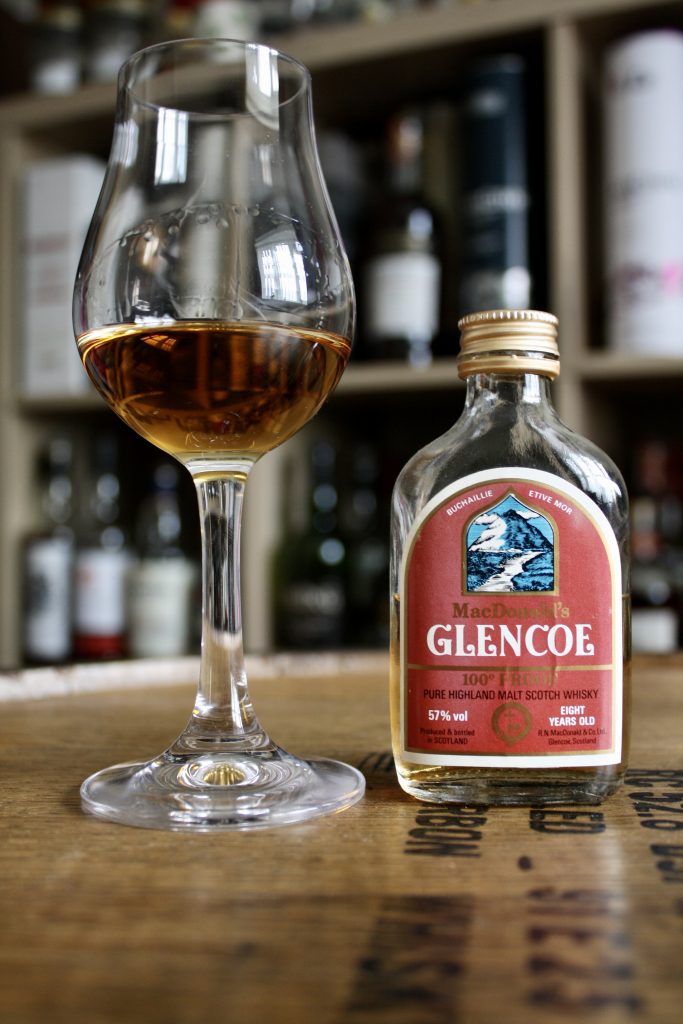
MacDonald’s Glencoe 8 Years Old 100 Proof (57% abv) 1970s/80s – Review
Colour : Amber
Nose : Really dark and not overly sweet sherry notes. Slightly burnt toffee, black treacle and heather honey at first, with orange zest, blackcurrant and sultana, all covered in vanilla cream. There’s vintage leather that’s seen better days, soy sauce, cafe latte, leaf mulch, old musty cupboards and coal tar. The addition of water brings out more vanilla sweetness.
Palate : Very drinkable at 57%, with very little in the way of alcohol burn. There is a little old bottle effect seemingly at play here, but its not a negative experience in this case, and many would tell you time in glass can improve a whisky. I don’t believe I have enough experience with older whisky to say. It’s thick and viscous on the palate. I’m getting treacle toffee and vanilla cream first, before blackcurrant, apple peels and dried fruits make themselves known. There’s toasted oak, which provides a bitterness, but its in check and soon moves towards chantilly cream and toasted hazelnut, with warming root ginger, and then a wonderfully wafting leaf fire smoke, along with barbecued red meats, rancio? The long finish brings more oak, cream, dried fruit and salt, with the subtle leaf fire smoke lingering on.
Conclusions : It tastes like an old style sherry, which I will caveat by saying it is not something I have a huge amount of experience with, but from what I read about that style of sherry before it was all seasoned casks to order, this is how I imagine it would be. The often crowd pleasing sherry sweetness you find today (particularly with 1st fill sherry finished whiskies) is darker than any I have experienced in more recent years, and its providing deep, rich, dark notes with a more subtle sweetness and lots of savoury. If this remains available for £4 for a miniature I will keep buying. Maybe I will try my luck for a full size bottle in a future auction. I’m a fan.
Score : 8/10
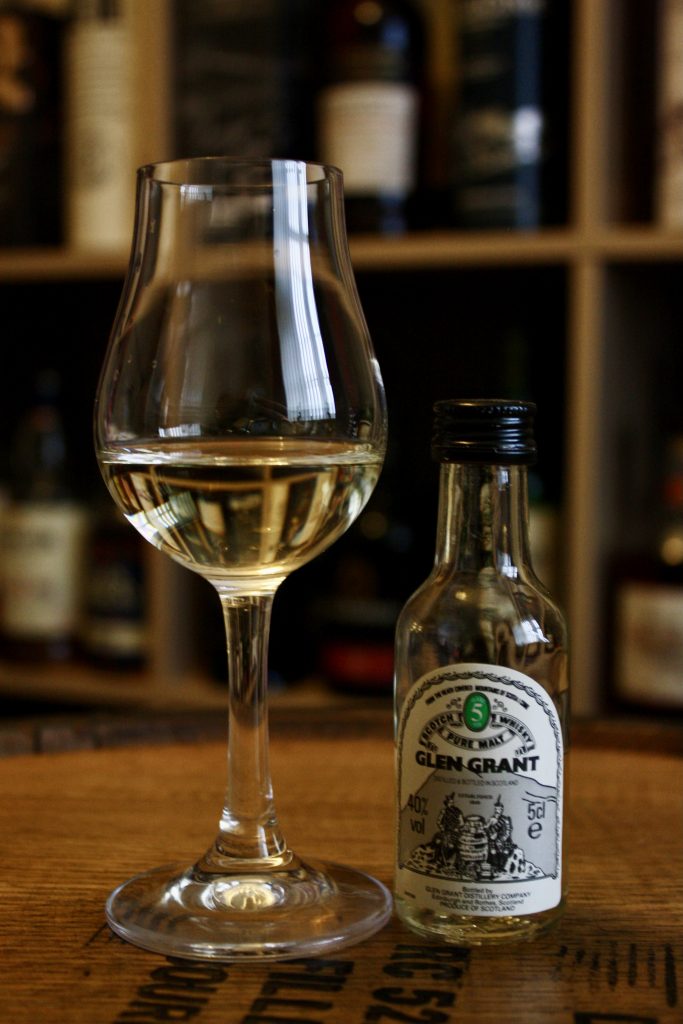
Anybody who follows any whisky auction – miniature or otherwise – will be well aware of the number of 5 year old Glen Grant bottles that come up. They sometimes hold a vintage statement on the label, and can be a cheap way to get that birth year malt. The Italian market is where they have been predominantly sold, and there is an interesting story behind that, which is told much better in this article than I would be able to say in a few sentences. The distillery has been owned by Italian company Campari since 2006. These versions of Glen Grant are not sought after by the aficionados, and I am expecting something very young and light. If I am honest, i’m not expecting much at all. If it were 1950’s Glen Grant, particularly from a sherry cask, that would be another matter. The serious old and rare collectors and drinkers go wild for that stuff, and prices go into the thousands for regular bottles. I paid £5 for this bottle. A full size version at auction will set you back around £40.
Glen Grant 5 Years Old 1980’s (40%) – Review
Colour : White Wine
Nose : Bright, fresh lemon and vanilla crème caramel. Pebbles, cardboard, and a little copper note. Not a lot to see here.
Palate : Thin; the thinnest of the thin whiskies I have experienced. Quite watery in flavour too. Big earthy-sweet icing sugar note, bitter lemon and oak, with a touch of peppery spice. The finish is very short and drying. A little creamy and nutty, with apple peels.
Conclusions : Ok…not much more to say about this. Perhaps it works in a hot Mediterranean climate, but I am failing to see what the Italian market loved about it. It is just about drinkable, and the nose isn’t completely dreadful, if not very interesting. There’s lots of this about at auction, so perhaps I will do somebody a favour and save them from buying one.
Score : 3/10
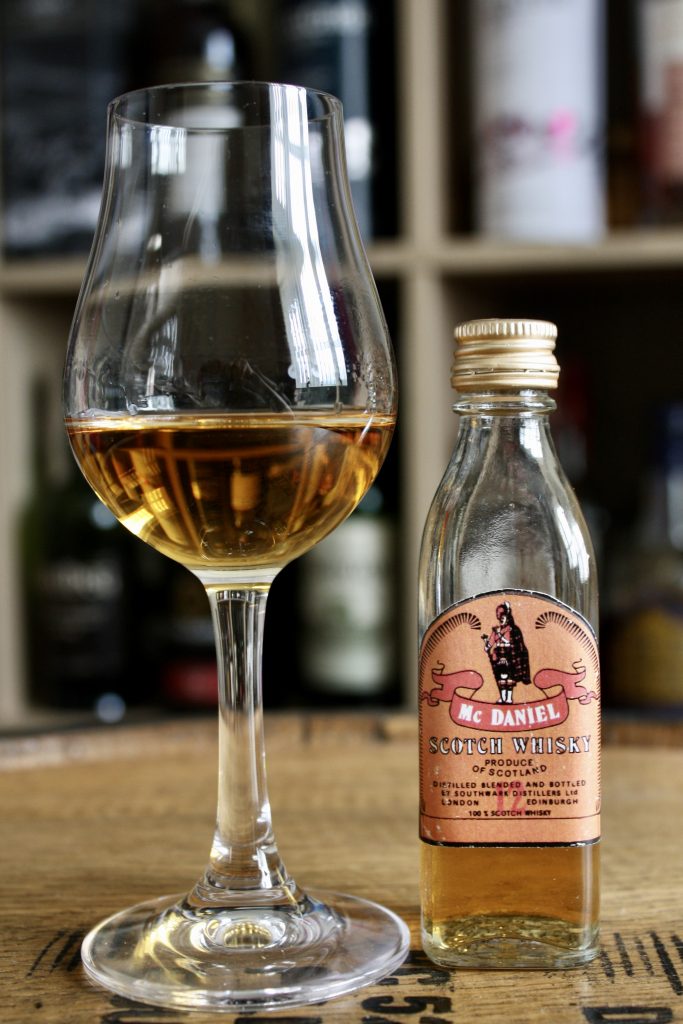
Let’s try a cheap blend from the 1970’s and see what we get. These are the kind of things you will pick up for a couple of quid. I paid £4 for a lot which contained this along with 4 other blends. Less than £1 each seemed worth a punt. McDaniel 12 year old is not one I can find much information about at all, other than it being produced by a company called Southwark distillers. The invaluable Schweppes Guide to Scotch tells us they were distillers of gin and vodka, but had brands such as this selling blended whiskies. They were part of Bartels, Rawlings International Limited. Bartels will be a name many of you will be familiar with today, and they are still a family run business selling independently bottled scotch whisky.
McDaniel 12 Years Old Blended Scotch Whisky 1970’s (40%) – Review
Colour : Gold
Nose : Quite a shy nose at first. It doesn’t leap out at you from the glass. There’s no old bottle effect to speak of here either. Giving it some time (important with these older bottlings) I start to get honey and orange marmalades. Makes me think of breakfast time deciding what to spread on my toast. There’s polished mahogany, bubblegum, toasted oak and vanilla. A good start.
Palate : Sweet orange and honey notes again initially, then turning bitter, and sawdust-y. We then get some cinder toffee, fresh cream, and a warming peppery spice on the mid-tongue. The bitter notes remain in the drying finish, which lets it down somewhat. More oak, acetone and metallic notes too.
Conclusions : Not the cracking old blend I hoped for. The orange and honey thing is really pleasant, but the bitter woodiness on the palate is where things fall apart. No complaints for less than £1, but I won’t rush out and get another. There are some good old blends out there, so don’t dismiss them. We’ll move on.
Score : 4/10
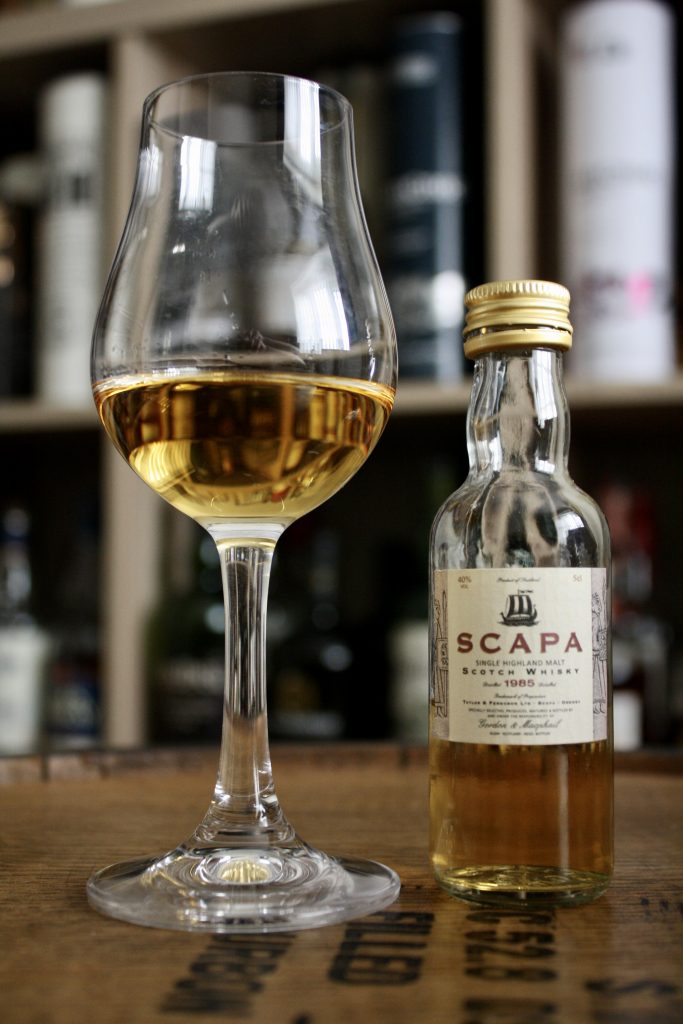
Oh dear, after the last two I feel like we need to pick up a little here. Let’s see if we can do better with a couple of vintage stated malts. I mentioned birth year whiskies in my last Glen Grant review earlier, and this Scapa is precisely that in my case. A 1985 vintage, which I believe was bottled at 10 years of age, but there is nothing on this label to confirm that. It is also a year which marked 100 years since the distillery was founded. Scapa’s existence is the reason independent bottlers can name all their Highland Park stock as ‘Unnamed’ or ‘Secret’ Orkney, with at least the tiniest shred of mystery intact. I must admit, I don’t have a lot of experience of drinking Scapa, mainly because it is so rare amongst the independent bottlers, and the current range doesn’t inspire me to open my wallet. The 40% bottling strength, lack of age statements and a £40+ price tag for each expression isn’t pulling me in. Although I did manage to pick up a Scapa Skiren for £14 recently, thanks to a friend who works in a supermarket and picked one up for me when he saw the crazy reduction. I need to try that before I write off Scapa as a viable purchasing choice in 2022. 40% whisky is still capable of being good, albeit we know it isn’t as good as it might be. On another relevant note, thank goodness for Gordon and Macphail. I have several of their miniatures from the likes of Glenrothes, Linkwood, Pulteney and Glen Mhor. They’re nearly always 40%, but worth seeking out.
Scapa 1985 Vintage Gordon and Macphail (40%) – Review
Colour : Rich Gold
Nose : Sweet heather honey, wood furniture polish, leather and wax jackets initially, but further nosing brings out its fruity side, with fresh red apples – both flesh and peels – along with pears. Malt, barley sugar and dusty stone floors round things off.
Palate : Not as thin as I expected being 40%. Sweet green apple and lemon juices, with honey and malt. It’s got a tickle of peppery spice on the palate, and a little harsh burn on the back of the throat, but not too much. As it develops we get vanilla cream and drying, slightly bitter oak. A moderate finish with apple peels, continuing oak and cream.
Conclusions : Solid if unspectacular. One I could happily sit and dram for a time, but not one to analyse too much. The flavours and aromas that are there are solid and nicely balanced. I’m happy to have a second one in the cupboard.
Score : 6/10
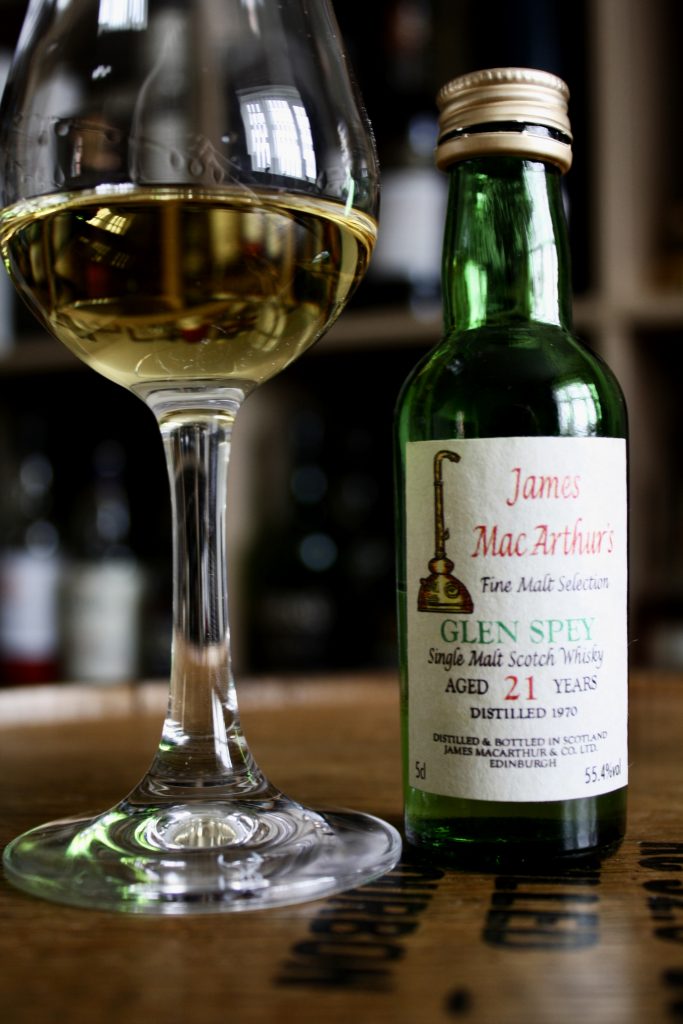
Glen Spey in Rothes must be one of the most under-the-radar distilleries in all of Scotland. Part of Diageo’s vast portfolio, it mostly goes into blends such as J&B, with only the Flora and Fauna 12 year old appearing as an official bottling. This 1970 vintage is 21 years old and bottled at cask strength, so it seemed like a worthwhile punt for £12. It is from the same independent bottler that released the Malt Mill mentioned earlier in the article, but without the same scarcity and story behind it, it can be had on the cheap. Incidentally, 1970 is the year the distillery moved from 2 to 4 stills.
Glen Spey 1970 Vintage 21 Years Old James MacArthur (55.4%) – Review
Colour : Barley
Nose : Creamy barley, with very zesty lemon and pineapple cube confectionery, along with a little WD-40 and chimney soot. It has a slightly mechanical edge to it I wasn’t expecting. There’s sweet crystallised ginger, toffee pennies, meadow flowers, white grapes and hazelnut. It’s wonderfully fresh and vibrant, especially given a drop of water and time in the glass.
Palate : Nice oily arrival on the palate. It’s surprisingly hot for a 21 year maturation, and we might need a drop of water…that’s better! The initial flavour is reminding me of a bitter lemon drink that is used as a mixer, with a good combination of sweet, sour and bitter sensations. I get some freshly sawn oak timber, peppery spice, ginger root and dried mango. Slightly later in the development we get Bounty coconut chocolate bar and almond milk. The finish is moderate in length and quite light, with a nutty, milky creaminess, a touch of oak, continuing warming ginger and apple peels.
Conclusions : This is lovely raw spirit from a fairly inactive cask. It feels like a real time capsule back to the distillate at Glen Spey in the early 70’s. It does need that few millilitres of water to tame the palate and bring out more flavour, but that’s the beauty of cask strength – just add the water a drop at a time until it is right for you.
Score : 7/10
I hope despite the very niche and not so easily obtainable nature of some of the drams I am reviewing, you enjoyed reading it, and can appreciate why old miniatures are worthwhile. I’ve enjoyed immensely cracking some open and discovering what they have to offer. Miniature collectors are often seen as oddballs – and maybe I am – but for me, its a great way to get into older whisky when you don’t have the budget to take chances on full size versions. They may not always be the best example of what the distillery was producing at the time, but I am grateful for the people who kept these for all these years, so people like me could buy and try them. The collectors and hoarders do have their uses.
Most of us cannot afford the types of old and rare whiskies we often read about from the old sages of the whisky game. If you want to take part in a Whisky Exchange Old and Rare tasting you are looking at £180 for 6 x 1cl samples. I am happy to settle with what I can afford, and there are gems to be uncovered as you can see above.
Let’s not forget the importance of the modern day miniature in all of this. There aren’t as many different whiskies sold as official miniatures as I would like to see, and they are a great way to try before you invest in a full bottle. Perhaps that is why some don’t sell them, for fear many would never return. I’ve started picking up more and more of them for the stash. One day I may want to look back at what those whiskies were like decades previous, and if not, a future miniature buyer like me may appreciate somebody hanging on to them all those years.

One Reply to “A stack of old miniatures”